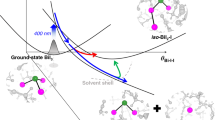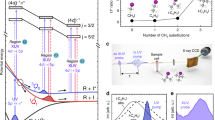Abstract
Solid-state reactions are influenced by the spatial arrangement of the reactants and the electrostatic environment of the lattice, which may enable lattice-directed chemical dynamics. Unlike the caging imposed by an inert matrix, an active lattice participates in the reaction, however, little evidence of such lattice participation has been gathered on ultrafast timescales due to the irreversibility of solid-state chemical systems. Here, by lowering the temperature to 80 K, we have been able to study the dissociative photochemistry of the triiodide anion (I3−) in single-crystal tetra-n-butylammonium triiodide using broadband transient absorption spectroscopy. We identified the coherently formed tetraiodide radical anion (I4•−) as a reaction intermediate. Its delayed appearance after that of the primary photoproduct, diiodide radical I2•−, indicates that I4•− was formed via a secondary reaction between a dissociated iodine radical (I•) and an adjacent I3−. This chemistry occurs as a result of the intermolecular interaction determined by the crystalline arrangement and is in stark contrast with previous solution studies.
This is a preview of subscription content, access via your institution
Access options
Access Nature and 54 other Nature Portfolio journals
Get Nature+, our best-value online-access subscription
$29.99 / 30 days
cancel any time
Subscribe to this journal
Receive 12 print issues and online access
$259.00 per year
only $21.58 per issue
Buy this article
- Purchase on Springer Link
- Instant access to full article PDF
Prices may be subject to local taxes which are calculated during checkout




Similar content being viewed by others
References
Nitzan, A. Chemical Dynamics in Condensed Phases: Relaxation, Transfer and Reactions in Condensed Molecular Systems (Oxford Univ. Press, 2006).
Harris, A. L., Brown, J. K. & Harris, C. B. The nature of simple photodissociation reactions in liquids on ultrafast time scales. Annu. Rev. Phys. Chem. 39, 341–366 (1988).
Owrutsky, J. C., Raftery, D. & Hochstrasser, R. M. Vibrational relaxation dynamics in solutions. Annu. Rev. Phys. Chem. 45, 519–555 (1994).
Elles, C. G. & Crim, F. F. Connecting chemical dynamics in gases and liquids. Annu. Rev. Phys. Chem. 57, 273–302 (2006).
Carpenter, B. K., Harvey, J. N. & Orr-Ewing, A. J. The study of reactive intermediates in condensed phases. J. Am. Chem. Soc. 138, 4695–4705 (2016).
Apkarian, V. A. & Schwentner, N. Molecular photodynamics in rare gas solids. Chem. Rev. 99, 1481–1514 (1999).
Hoops, A. A., Gascooke, J. R., Faulhaber, A. E., Kautzman, K. E. & Neumark, D. M. Two- and three-body photodissociation of gas phase I3−. J. Chem. Phys. 120, 7901–7909 (2004).
Nakanishi, R. et al. Photodissociation of gas-phase I3−: comprehensive understanding of nonadiabatic dissociation dynamics. J. Chem. Phys. 126, 204311 (2007).
Banin, U. & Ruhman, S. Ultrafast photodissociation of I3. Coherent photochemistry in solution. J. Chem. Phys. 98, 4391–4403 (1993).
Kühne, T. & Vöhringer, P. Vibrational relaxation and geminate recombination in the femtosecond-photodissociation of triiodide in solution. J. Chem. Phys. 105, 10788–10802 (1996).
Poulin, P. R. Coherent Lattice and Molecular Dynamics in Ultrafast Single-Shot Spectroscopy (MIT, 2005).
Nishiyama, Y., Terazima, M. & Kimura, Y. Ultrafast relaxation and reaction of diiodide anion after photodissociation of triiodide in room-temperature ionic liquids. J. Phys. Chem. B 116, 9023–9032 (2012).
Poulin, P. R. & Nelson, K. A. Irreversible organic crystalline chemistry monitored in real time. Science 313, 1756–1760 (2006).
Gershgoren, E., Banin, U. & Ruhman, S. Caging and geminate recombination following photolysis of triiodide in solution. J. Phys. Chem. A 102, 9–16 (1998).
Johnson, A. E. & Myers, A. B. Solvent effects in the Raman spectra of the triiodide ion: observation of dynamic symmetry breaking and solvent degrees of freedom. J. Phys. Chem. 100, 7778–7788 (1996).
Kim, K. H. et al. Solvent-dependent molecular structure of ionic species directly measured by ultrafast X-ray solution scattering. Phys. Rev. Lett. 110, 165505 (2013).
Svensson, P. H. & Kloo, L. Synthesis, structure, and bonding in polyiodide and metal iodide-iodine systems. Chem. Rev. 103, 1649–1684 (2003).
Gabes, W. & Gerding, H. Vibrational spectra and structures of the trihalide ions. J. Mol. Struct. 14, 267–279 (1972).
Zambounis, J. S., Kamitsos, E. I., Patsis, A. P. & Papavassiliou, G. C. Resonance Raman and far-infrared studies of n-Bu4NI3 and n-Bu4NBr3 . J. Raman Spectrosc. 23, 81–85 (1992).
Broude, V. L., Rashba, E. I. & Sheka, E. F. Spectroscopy of Molecular Excitons (Springer, 1985).
Baratz, A. & Ruhman, S. UV photolysis of I3− in solution — multiple product channels detected by transient hyperspectral probing. Chem. Phys. Lett. 461, 211–217 (2008).
Prokhorenko, V. I. Global analysis of multi-dimensional experimental data. Eur. Photochem. Assoc. Newsl. June, 21–23 (2012).
Stoica, P. & Moses, R. L. Spectral Analysis of Signals (Pearson Prentice Hall, 2005).
Kühne, T., Küster, R. & Vöhringer, P. Femtosecond photodissociation of triiodide in solution: excitation energy dependence and transition state dynamics. Chem. Phys. 233, 161–178 (1998).
Mallat, S. A Wavelet Tour of Signal Processing: The Sparse Way (Academic, 2008).
Brazard, J., Bizimana, L. A., Gellen, T., Carbery, W. P. & Turner, D. B. Experimental detection of branching at a conical intersection in a highly fluorescent molecule. J. Phys. Chem. Lett. 7, 14–19 (2016).
Pollard, W. T. et al. Theory of dynamic absorption spectroscopy of nonstationary states. 4. Application to 12-fs resonant impulsive Raman spectroscopy of bacteriorhodopsin. J. Phys. Chem. 96, 6147–6158 (1992).
Wang, Q., Schoenlein, R., Peteanu, L., Mathies, R. & Shank, C. Vibrationally coherent photochemistry in the femtosecond primary event of vision. Science 266, 422–424 (1994).
de Violet, P. F. Polyhalide radical anions as intermediates in chemistry. Rev. Chem. Intermed. 4, 121–169 (1981).
Fornier de Violet, P., Bonneau, R. & Joussot-Dubien, J. Laser flash photolysis of iodine–iodide mixture in hydroxylic solvent. Evidence for the existence of the radical anion I4−. Chem. Phys. Lett. 28, 569–572 (1974).
Shida, T., Takahashi, Y., Hatano, H. & Imamura, M. Electronic structures of I2− and I4− ions in γ-irradiated rigid solutions. Chem. Phys. Lett. 33, 491–494 (1975).
Johnson, P. J. M. et al. Local vibrational coherences drive the primary photochemistry of vision. Nat. Chem. 7, 980–986 (2015).
Müller, M. et al. Anion–π interactions in salts with polyhalide anions: trapping of I42−. Chemistry 16, 12446–12453 (2010).
Manca, G., Ienco, A. & Mealli, C. Factors controlling asymmetrization of the simplest linear I3– and I42– polyiodides with implications for the nature of halogen bonding. Cryst. Growth Des. 12, 1762–1771 (2012).
Tellinghuisen, J. Analysis of the visible absorption spectrum of I2 in inert solvents using a physical model. J. Phys. Chem. A 116, 391–398 (2012).
Guo, Z., Molesky, B. P., Cheshire, T. P. & Moran, A. M. Elucidation of reactive wavepackets by two-dimensional resonance Raman spectroscopy. J. Chem. Phys. 143, 124202 (2015).
Schwartz, B. J., King, J. C. & Harris, C. B. in Ultrafast Dynamics of Chemical Systems 235–248 (Springer Netherlands, 1994).
Mukamel, S. Principles of Nonlinear Optical Spectroscopy (Oxford Univ. Press, 1999).
Orr-Ewing, A. J. Perspective: bimolecular chemical reaction dynamics in liquids. J. Chem. Phys. 140, 90901 (2014).
Sherwood, P. M. A. Vibrational spectroscopy of solids (Cambridge Univ. Press, 1972).
Marino, A. et al. Activation of coherent lattice phonon following ultrafast molecular spin-state photo-switching: a molecule-to-lattice energy transfer. Struct. Dyn. 3, 23605 (2016).
Field, R., Liu, L. C., Gawelda, W., Lu, C. & Miller, R. J. D. Spectral signatures of ultrafast spin crossover in single crystal [FeII(bpy)3](PF6)2 . Chemistry 22, 5118–5122 (2016).
Gühr, M. in Coherent Vibrational Dynamics (CRC Press, 2007).
Miller, R. J. D. Femtosecond crystallography with ultrabright electrons and x-rays: capturing chemistry in action. Science 343, 1108–1116 (2014).
Kirchner, F. O., Lahme, S., Riedle, E. & Baum, P. All-reflective UV-VIS-NIR transmission and fluorescence spectrometer for μm-sized samples. AIP Adv. 4, 77134 (2014).
Brotherton, W. S., Clark, R. J. & Zhu, L. Synthesis of 5-iodo-1,4-disubstituted-1,2,3-triazoles mediated by in situ generated copper(I) catalyst and electrophilic triiodide ion. J. Org. Chem. 77, 6443–6455 (2012).
Perdew, J. P., Burke, K. & Ernzerhof, M. Generalized gradient approximation made simple. Phys. Rev. Lett. 77, 3865–3868 (1996).
Tkatchenko, A. & Scheffler, M. Accurate molecular van der Waals interactions from ground-state electron density and free-atom reference data. Phys. Rev. Lett. 102, 73005 (2009).
Martin, J. M. L. & Sundermann, A. Correlation consistent valence basis sets for use with the Stuttgart–Dresden–Bonn relativistic effective core potentials: the atoms Ga–Kr and In–Xe. J. Chem. Phys. 114, 3408–3420 (2001).
Groenewald, F., Esterhuysen, C. & Dillen, J. Extensive theoretical investigation: influence of the electrostatic environment on the I3−···I3− anion–anion interaction. Theor. Chem. Acc. 131, 1281 (2012).
Acknowledgements
We thank A. G. Dijkstra and M. A. Kochman for helpful discussions, and D. S. Badali for contributions to the initial development of the transient absorption setup. This work was funded by the Max Planck Society with additional support from the Hamburg Centre for Ultrafast Imaging. G.C. acknowledges the support from the Alexander von Humboldt Foundation. D.M.R. and C.A.M. acknowledge the UK Car-Parrinello Consortium for allocation of computing time on the EPSRC high performance computing resource ARCHER (managed by the Edinburgh Parallel Computing Centre), the EaStCHEM Research Computing Facility and the University of Edinburgh ECDF facility.
Author information
Authors and Affiliations
Contributions
R.J.D.M. conceived the experiment. R.X. grew TBAT crystals and prepared samples for optical measurements; G.C. constructed and programmed the experimental setups and R.X. modified the setups for the current experiment; R.X. performed the measurements with contributions from G.C.; R.X. analysed and interpreted the data under the supervision of V.I.P and S.A.H.; D.M.R. and C.A.M. carried out the quantum chemical calculations and wrote the theory sections of the manuscript; R.X. wrote the manuscript with contributions from G.C. and V.I.P.; all authors contributed to editing the manuscript to its final form.
Corresponding author
Ethics declarations
Competing interests
The authors declare no competing financial interests.
Supplementary information
Supplementary information
Supplementary information (PDF 12270 kb)
Rights and permissions
About this article
Cite this article
Xian, R., Corthey, G., Rogers, D. et al. Coherent ultrafast lattice-directed reaction dynamics of triiodide anion photodissociation. Nature Chem 9, 516–522 (2017). https://doi.org/10.1038/nchem.2751
Received:
Accepted:
Published:
Issue Date:
DOI: https://doi.org/10.1038/nchem.2751
This article is cited by
-
A chain-type diamine strategy towards strongly anisotropic triiodide of DMEDA·I6
Science China Materials (2020)
-
Caught in the act
Nature Chemistry (2017)



